The Fox Hunt 60 Years Later
What is common between a cell phone and a camping bowl?
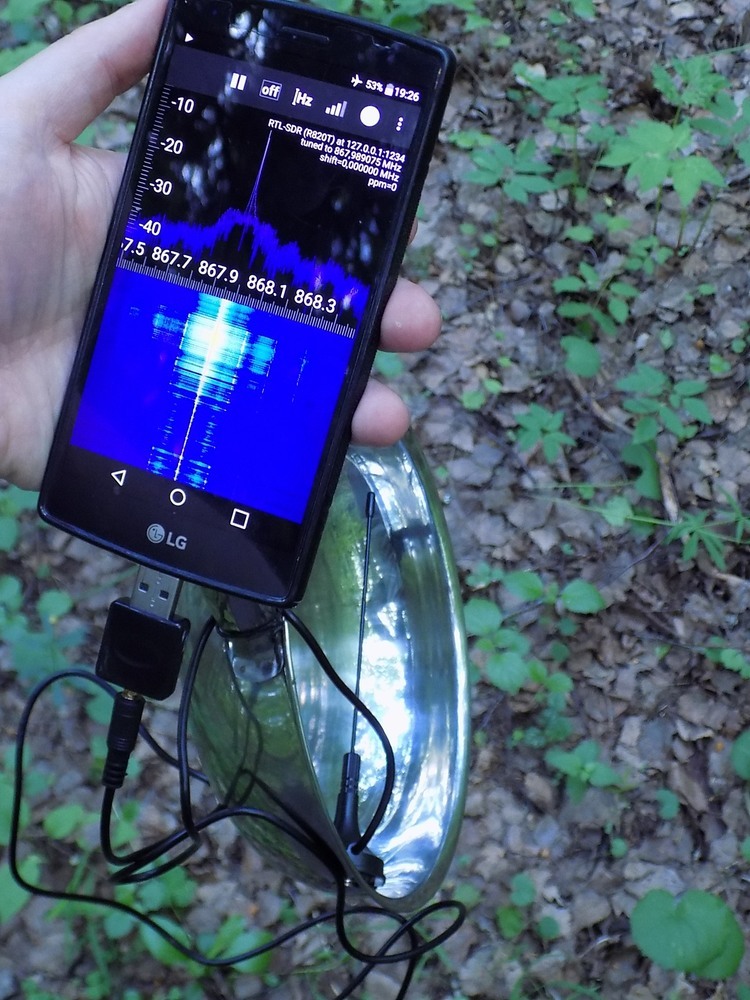
Many have heard of the "Fox Hunt" - a special variant of orienteering - sports direction finding. When I was a child, when I visited a radio circle, I read a lot about this sport and even dreamed of assembling my own direction finder. But we moved, I stopped going to the circle, became interested in programming, stuck out in front of the computer and never collected ...
')
And now, after 20 years, I did it in an extremely unusual form ...
Recently, I have been playing a lot with SDR and talk about my experiences: one and two times .
Going with the children on a hike together with the school company, I decided to add fox hunting for the time to my beloved children, but to the usual rope crossings, orienteering, burning the rope with a fire.
The idea came spontaneously: in the winter, for comparison, I bought several different SDR receivers on Aliexpress (in fact, these are DVB receivers, a little about them here ) and with their help I studied the quality of antennas and the range of Z-Wave devices. At some point, I noticed that in the adjacent range (at 868.1 MHz, while Z-Wave at 869.0 MHz) something is noisy once a minute, I wondered “where did the sound come from” and went looking for a source by signal level and direction . As a result, it turned out to be the secret police at the neighbors. So I thought that out of "matches and acorns," you can make good fun.
We do!
Let's start with the transmitter. The houses and colleagues from the last CCC 2015 still have wonderful rad1o badge . This toy is great for the role of "fox".

For rad1o, there is a HackRF compatible firmware that allows you to use rad1o with GNU Radio and other SDR programs.
For better range, instead of the standard F-antenna tuned to 2.4 GHz, I soldered the SMA connector and screwed the whip antenna at 868 MHz.
I used GNU Radio to generate a signal. The project was simply to generate a signal from Signal Source directly to osmocom Sink. Also twisted the RF gain and the amplitude of the signal to increase the range.
rad1o was also convenient due to the presence of a battery, as well as the fact that when it was disconnected from USB (i.e. from GNU Radio on my PC), it continued to generate the latest data, i.e. stupidly shone on the frequency I need. This enabled, after switching on the transmission, remove the USB and carry the “fox” to the specified location. The system turned out compact and completely autonomous.
The most important thing is to assemble detectors with a more or less narrow radiation pattern, and even in a simple version, wearable, two or three sets, preferably without a collective farm, because the time before the hike was not enough.
As a receiver, I took DVB-sticks from the previous article , connected them to a cell phone for Android, using a USB OTG adapter. For visualization, I chose the RF Analyzer already familiar to me from past experiments. The program has a convenient mode of displaying the spectrum at the current moment and in the form of waterfall. The photo of the program was on KDPV.
Since DVB is eating an incredibly large amount of energy, several power bank have been prepared for setting up phones in the field.
Separately, I wanted to draw attention to the very successful USB OTG adapter from Olimex . In contrast to the flexible cable on which the receiver hangs, it provides a rigid fixation. And it is so small that it is just convenient to carry it with you, just in case.
The standard pin from my DVB receivers is good, but not very directional. I wanted to make a nominal directional antenna, such as Yagu. But on DVB receivers MCX connectors are used, for which I have not found the plugs for 4 days in Moscow. I did not really want to cut the antennas, and I began to look for a tolerable reflector for the staff ones.
The first thought - well, you can shove the pin into the tin can, you get a steep waveguide. Many people do this at summer houses for confident reception of 3G. But a quick calculation showed that I didn’t need a can of bank, but rather from under a paint with a diameter of at least 21 cm (otherwise the wave would not fit there because my frequency is lower than the cut-off frequency). I didn’t want to run with such a jar ... Yes, and it was necessary to search for jars, pour out paint, get my hands dirty. I also didn’t want to increase the frequency, because in a dense forest, waves less than 30 cm are easily trapped by trees and the antennas for transmitters at 868 MHz were on hand in large numbers from the work associated with Z-Wave.
In general, I played with foil, iron sheets and other improvised means, until the night before when assembling a backpack I came across ordinary such hiking bowls . Here he is a reflector of my dreams!
As always, I started preparing in advance, and did everything on the last night;)
It turned out very well that their diameter was about λ / 2. The wall at the bowl at 90 ° bottom, you can attach an antenna to it. A standard anethnna is bad for a bowl (there is a magnet on the bottom of the antenna), but if you attach a small flat magnet on the back side, it holds just fine. In addition, the bowl has a convenient handle, for which it can be held and sent in the right direction.
There is another important point. Just fitting a bowl is not enough. To make it a good counterweight and cut off the signal from the outside, it was decided to connect it to the ground. To do this, I carefully opened the leg of the antenna, where there is a magnet and a metal washer with a diameter of 2.5 cm, which acts as a ground plane. He soldered a short posting to this plate, filled the place of soldering with a drop from a pistol, so that the soldering did not fall off at that very moment, since the wire had to be bent.
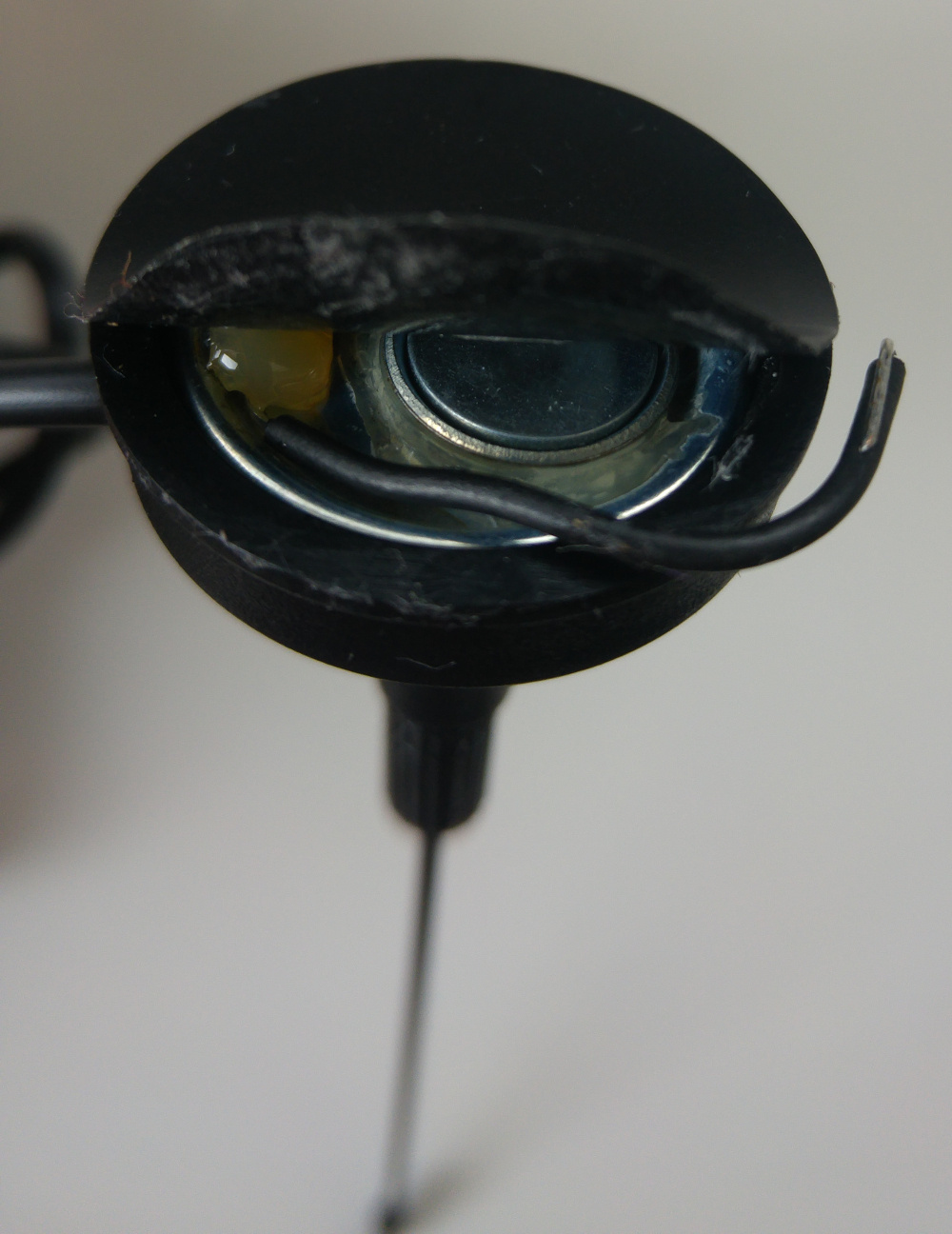
I connected this wire to the bowl by pressing it with a magnet. In field conditions, instead of a tester, I used a LED and a CR2032 battery to check that the current from the external ring of the MCX connector (the ground at the antenna plug) goes to the bowl, i.e. the bowl is connected to the ground.
The result was such a set:
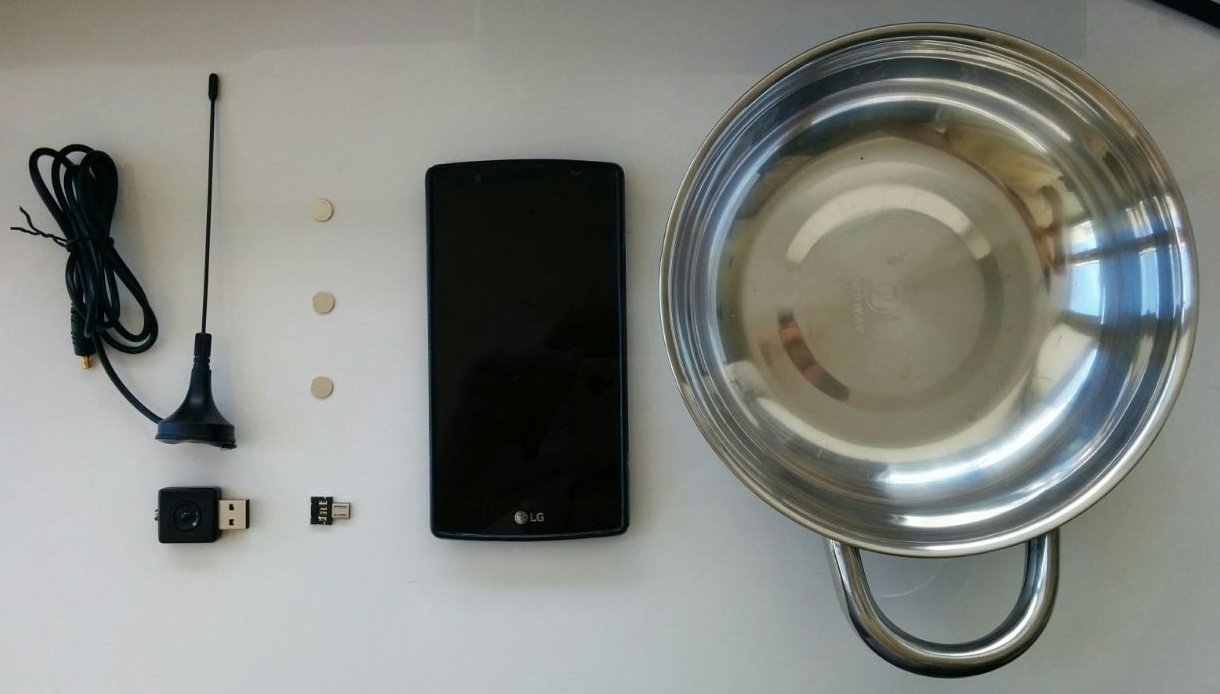
And when assembled, it turned into this:
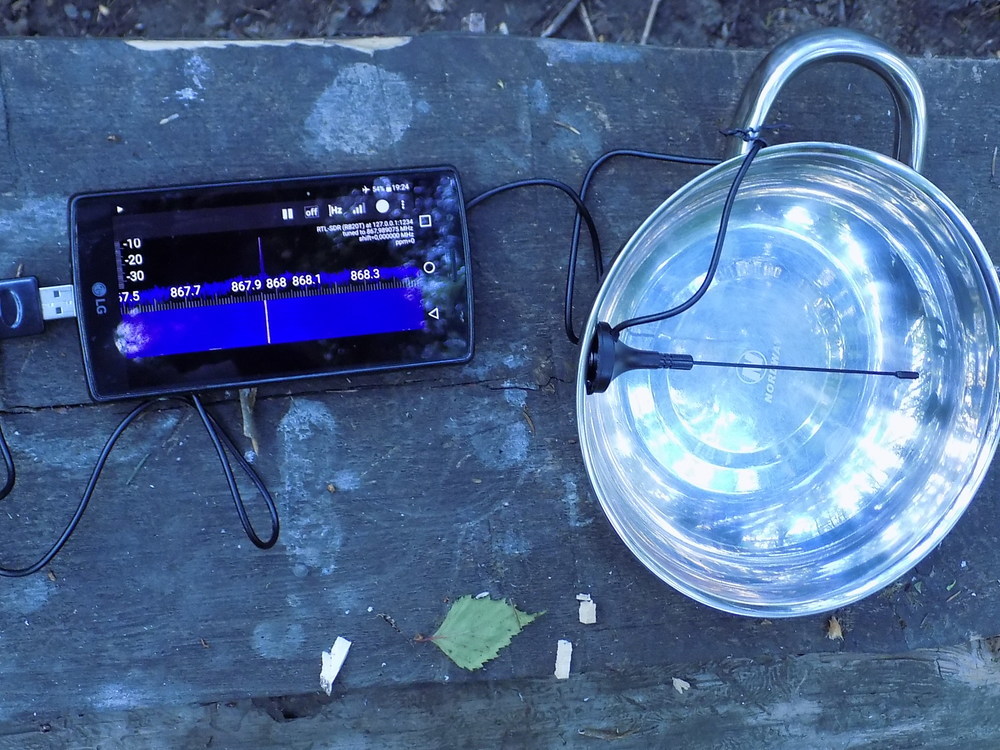
All this happened not far from Gorky-10 (Rublevka), so I chose the frequencies allowed for unlicensed civilian connections with a power limit of 20 mW for the entire case. Chose 868.0 and 869.0 MHz. Fox was "heard" for 300 meters, so I was not very worried, but I didn’t really want to explain to the local security personnel why I had occupied some frequencies.
By the way, now the metal bowl has become a dual-purpose device, and it can be taken away from any hiker!
At first I checked the toy for two adults who only remotely heard about such a game. Well, on myself - I went to pick up the transmitter after checking and forgot what tree it stood under. I had to look for the fox myself;)
After checking the ideas for consistency and working off the technology, they gave all this to children (from 2 to 8 classes). A minute of explanation of what we are looking for and where to look, and they ran away with a bowl in their hand.
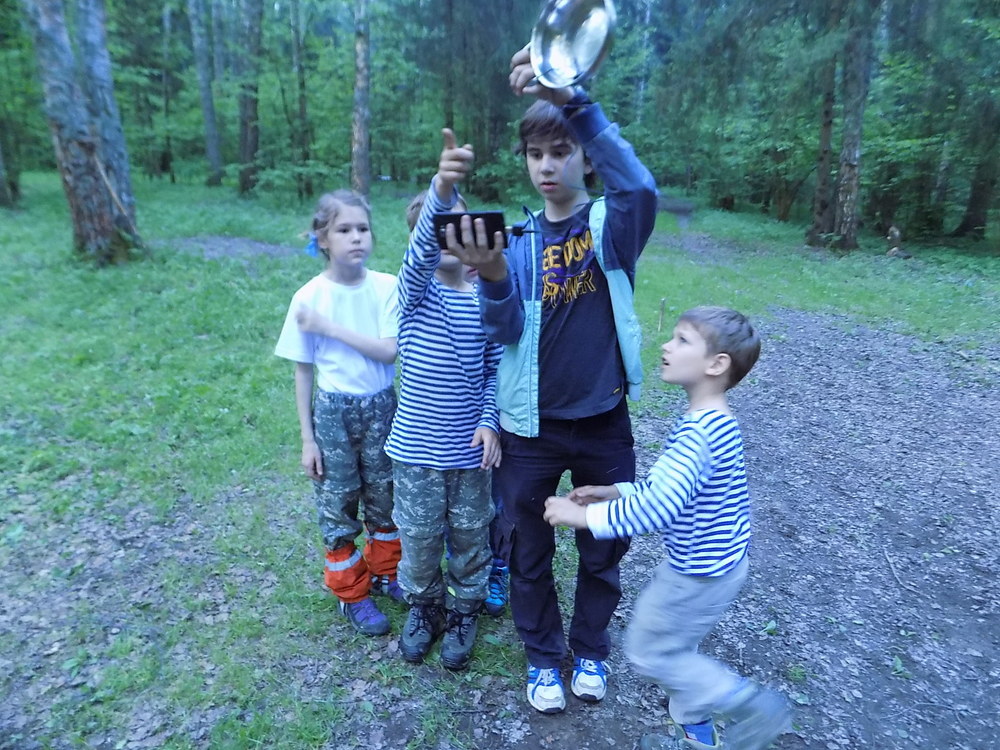
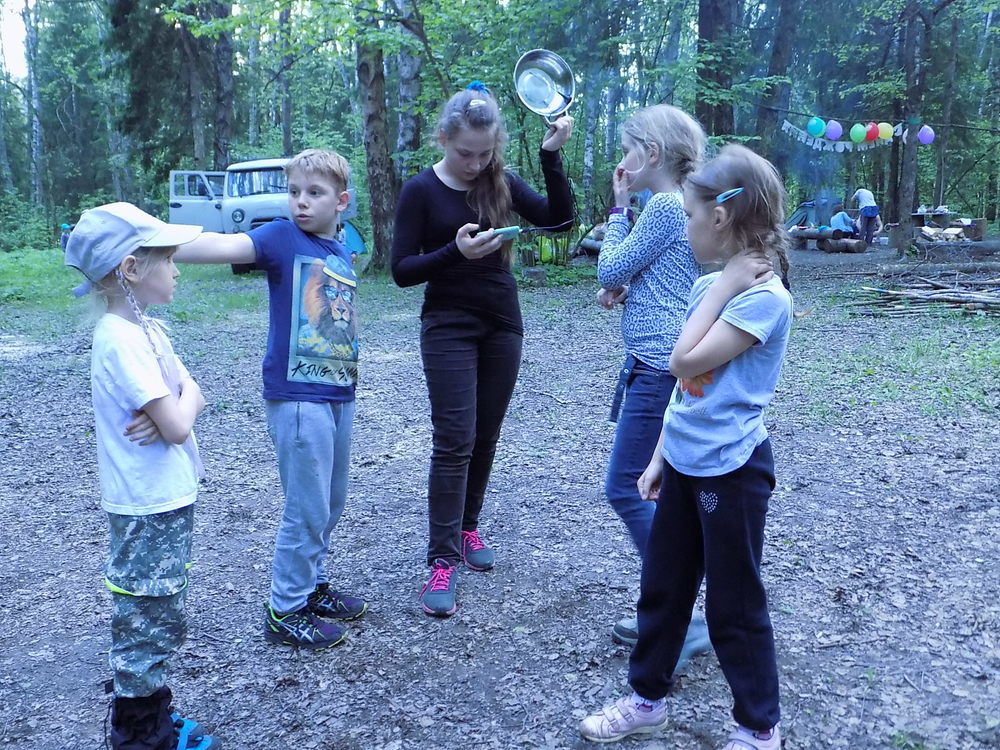
There were two foxes, two teams were looking for two different transmitters. As a result, one team took less than 5 minutes to search, another 10 minutes to randomly throwing around the clearing, after which they attacked the trail, and realized that it was easier to look at the color in watefall, and not on the graph from above.
Fox:
Radio finder:
This was the first experience. It turned out fun, but next time we will do better!
Of course, improving the antenna will help determine the direction faster. Yaga looks like an obvious candidate, but you can try others. In addition, the Yagu can be made on the spot with hands competing from improvised forest materials and harvested metal pins.
For complication, you can not transfer all the time, but, for example, once a minute. But for this you need to make the transmitter visible from a greater distance, have a directional antenna and distribute maps. It will be more like a classic sports version.
Further, you can not just “shine”, but send an FM message with prompts. RF Analyzer has a built-in decoder. Or morse code. This already requires either a permanently connected PC, or writing l0adable for rad1o — a program for rad1o firmware. For convenience, there is rflib.
It will also be interesting not to report exact frequencies, but simply to indicate a wide range. Let the teams look for the nearest one and choose the order of the route.
By coupon GT_ARDF for a week in the store 5smart.com a 10% discount on the entire range of Z-Wave equipment.
We also watch our new educational videos about home automation with our own hands .
Many have heard of the "Fox Hunt" - a special variant of orienteering - sports direction finding. When I was a child, when I visited a radio circle, I read a lot about this sport and even dreamed of assembling my own direction finder. But we moved, I stopped going to the circle, became interested in programming, stuck out in front of the computer and never collected ...
')
And now, after 20 years, I did it in an extremely unusual form ...
Recently, I have been playing a lot with SDR and talk about my experiences: one and two times .
Going with the children on a hike together with the school company, I decided to add fox hunting for the time to my beloved children, but to the usual rope crossings, orienteering, burning the rope with a fire.
The idea came spontaneously: in the winter, for comparison, I bought several different SDR receivers on Aliexpress (in fact, these are DVB receivers, a little about them here ) and with their help I studied the quality of antennas and the range of Z-Wave devices. At some point, I noticed that in the adjacent range (at 868.1 MHz, while Z-Wave at 869.0 MHz) something is noisy once a minute, I wondered “where did the sound come from” and went looking for a source by signal level and direction . As a result, it turned out to be the secret police at the neighbors. So I thought that out of "matches and acorns," you can make good fun.
We do!
Fox
Let's start with the transmitter. The houses and colleagues from the last CCC 2015 still have wonderful rad1o badge . This toy is great for the role of "fox".

For rad1o, there is a HackRF compatible firmware that allows you to use rad1o with GNU Radio and other SDR programs.
For better range, instead of the standard F-antenna tuned to 2.4 GHz, I soldered the SMA connector and screwed the whip antenna at 868 MHz.
I used GNU Radio to generate a signal. The project was simply to generate a signal from Signal Source directly to osmocom Sink. Also twisted the RF gain and the amplitude of the signal to increase the range.
rad1o was also convenient due to the presence of a battery, as well as the fact that when it was disconnected from USB (i.e. from GNU Radio on my PC), it continued to generate the latest data, i.e. stupidly shone on the frequency I need. This enabled, after switching on the transmission, remove the USB and carry the “fox” to the specified location. The system turned out compact and completely autonomous.
Radio direction finders
The most important thing is to assemble detectors with a more or less narrow radiation pattern, and even in a simple version, wearable, two or three sets, preferably without a collective farm, because the time before the hike was not enough.
As a receiver, I took DVB-sticks from the previous article , connected them to a cell phone for Android, using a USB OTG adapter. For visualization, I chose the RF Analyzer already familiar to me from past experiments. The program has a convenient mode of displaying the spectrum at the current moment and in the form of waterfall. The photo of the program was on KDPV.
Since DVB is eating an incredibly large amount of energy, several power bank have been prepared for setting up phones in the field.
Separately, I wanted to draw attention to the very successful USB OTG adapter from Olimex . In contrast to the flexible cable on which the receiver hangs, it provides a rigid fixation. And it is so small that it is just convenient to carry it with you, just in case.
Antenna
The standard pin from my DVB receivers is good, but not very directional. I wanted to make a nominal directional antenna, such as Yagu. But on DVB receivers MCX connectors are used, for which I have not found the plugs for 4 days in Moscow. I did not really want to cut the antennas, and I began to look for a tolerable reflector for the staff ones.
The first thought - well, you can shove the pin into the tin can, you get a steep waveguide. Many people do this at summer houses for confident reception of 3G. But a quick calculation showed that I didn’t need a can of bank, but rather from under a paint with a diameter of at least 21 cm (otherwise the wave would not fit there because my frequency is lower than the cut-off frequency). I didn’t want to run with such a jar ... Yes, and it was necessary to search for jars, pour out paint, get my hands dirty. I also didn’t want to increase the frequency, because in a dense forest, waves less than 30 cm are easily trapped by trees and the antennas for transmitters at 868 MHz were on hand in large numbers from the work associated with Z-Wave.
In general, I played with foil, iron sheets and other improvised means, until the night before when assembling a backpack I came across ordinary such hiking bowls . Here he is a reflector of my dreams!
As always, I started preparing in advance, and did everything on the last night;)
It turned out very well that their diameter was about λ / 2. The wall at the bowl at 90 ° bottom, you can attach an antenna to it. A standard anethnna is bad for a bowl (there is a magnet on the bottom of the antenna), but if you attach a small flat magnet on the back side, it holds just fine. In addition, the bowl has a convenient handle, for which it can be held and sent in the right direction.
There is another important point. Just fitting a bowl is not enough. To make it a good counterweight and cut off the signal from the outside, it was decided to connect it to the ground. To do this, I carefully opened the leg of the antenna, where there is a magnet and a metal washer with a diameter of 2.5 cm, which acts as a ground plane. He soldered a short posting to this plate, filled the place of soldering with a drop from a pistol, so that the soldering did not fall off at that very moment, since the wire had to be bent.

I connected this wire to the bowl by pressing it with a magnet. In field conditions, instead of a tester, I used a LED and a CR2032 battery to check that the current from the external ring of the MCX connector (the ground at the antenna plug) goes to the bowl, i.e. the bowl is connected to the ground.
The result was such a set:

And when assembled, it turned into this:
FSO somewhere near
All this happened not far from Gorky-10 (Rublevka), so I chose the frequencies allowed for unlicensed civilian connections with a power limit of 20 mW for the entire case. Chose 868.0 and 869.0 MHz. Fox was "heard" for 300 meters, so I was not very worried, but I didn’t really want to explain to the local security personnel why I had occupied some frequencies.
By the way, now the metal bowl has become a dual-purpose device, and it can be taken away from any hiker!
Ran
At first I checked the toy for two adults who only remotely heard about such a game. Well, on myself - I went to pick up the transmitter after checking and forgot what tree it stood under. I had to look for the fox myself;)
After checking the ideas for consistency and working off the technology, they gave all this to children (from 2 to 8 classes). A minute of explanation of what we are looking for and where to look, and they ran away with a bowl in their hand.
There were two foxes, two teams were looking for two different transmitters. As a result, one team took less than 5 minutes to search, another 10 minutes to randomly throwing around the clearing, after which they attacked the trail, and realized that it was easier to look at the color in watefall, and not on the graph from above.
Price
Fox:
- ~ $ 250 HackRF or rad1o badge
Radio finder:
- $ 8 DVB receiver on Aliexpress (I had one)
- 240 rub USB OTG (you can get cheaper)
- ~ 200 rub bowl (already) - also allows you to eat
- ~ 10 rub magnets (were also on the fridge)
- 43 rub prog RF Analyzer - it is possible to collect from surses for free, but you can also say the author thank you
- 0 rub cell phone (everyone has a student)
What can be improved
This was the first experience. It turned out fun, but next time we will do better!
Of course, improving the antenna will help determine the direction faster. Yaga looks like an obvious candidate, but you can try others. In addition, the Yagu can be made on the spot with hands competing from improvised forest materials and harvested metal pins.
For complication, you can not transfer all the time, but, for example, once a minute. But for this you need to make the transmitter visible from a greater distance, have a directional antenna and distribute maps. It will be more like a classic sports version.
Further, you can not just “shine”, but send an FM message with prompts. RF Analyzer has a built-in decoder. Or morse code. This already requires either a permanently connected PC, or writing l0adable for rad1o — a program for rad1o firmware. For convenience, there is rflib.
It will also be interesting not to report exact frequencies, but simply to indicate a wide range. Let the teams look for the nearest one and choose the order of the route.
Bonus
By coupon GT_ARDF for a week in the store 5smart.com a 10% discount on the entire range of Z-Wave equipment.
We also watch our new educational videos about home automation with our own hands .
Source: https://habr.com/ru/post/395061/
All Articles